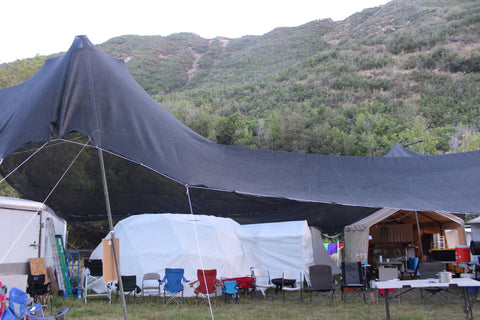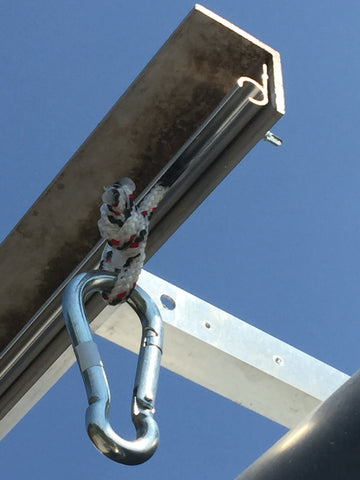The past several years I have had weeklong camps with other campers, both experienced and novices. Our locations have limited shade, so most tents are in the sun all day long. This has proven instructive regarding which tents do better in the sun and which tents to avoid. But more importantly, it has taught us how to alleviate the problem of direct sun on our tents which caused unbearable temperatures inside. This was accomplished through the use of shade cloth and/or insulation.
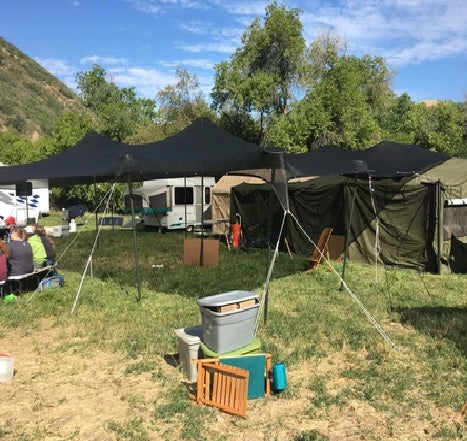
I was the only tent that used insulation and I will share my story in another blog post. Of the other five campers surveyed for this article, four used shade cloth and one used an extended rain fly/tarp, which covered his tent and extended 10 feet over the two sides and the front of his tent. The tarp user is respondent #5. His comments are in red to distinguish them from the shade cloth users.
Here are the questions I asked and their responses:
Why did you purchase shade cloth?
1. Two reasons: 1. We noticed a significant difference at the camp last year compared to the previous year in the temperature of the tents that had shade cloth over them. This was noticeable again this year as so many more camps had shade cloth. 2. As camp captains this year, we had a responsibility to provide some shade for class and eating areas that just a couple of pop-up awnings would not adequately provide.
2. Originally I purchased shade cloth to provide shade for classes at the camp. After last year’s experience that was so hot, I decided to cover all of my tents and out buildings.
3. Due to my experience at last year's camp and wanting to be more comfortable this year. I also experienced the cooling effect of others who had shade cloth over their tents last year.
4. To make camp more comfortable.
5. I wanted greater protection from the sun, the heat, the rain, the wind, etc.
What size did you buy?
1. Our shade cloths are repurposed from a previous use. These were originally 6 ft wide and came in rolls of about 75 ft long. We elected to sew them together to make ~18 ft X 35 ft shade cloths, which we then set up side by side for approximately a 36 ft square area.
2. I purchased 2 pieces 25 by 50 and connected them together for a 50 by 50 piece. That was large enough to cover everything.
3. Two 30x30 ft cloths with grommets every 2 feet. I connected them together for a 30’x60’ covering.
4. Two 25x50 pieces, hooked together for a 50x50.
5. 28’ x 40’
What area did you cover? Tent, seating/eating area, meeting area?
1. We set this up over our food prep / dining / class common area in our camp. You can see our camp to the left with the green shade cloth, white trailer and the tipi. The green shade cloth at the left is where pieces were tied together. This was the eating/classroom area. The tent to the right has shade cloth draping over their tent. I don't have information regarding the effectiveness of draping the shade cloth or suspending it with poles.
2. Tent, seating/eating area, and meeting area. These photos show the 50x50 ft. shade cloth. Notice the cord that is threaded through the grommets. This is explained in a later comment.
3. Tent, seating/eating area, meeting area? My shade cloth covered most of the kitchen and main section of our tent, which is 35' long x 18' wide. Unfortunately there are no photos of this camp, but this camper had a very creative way of attaching one end of his shade cloth to his trailer. His description -
We wanted to take advantage of our trailer parked next to our tent to attach and secure our shade cloth. To facilitate this I purchase some awning track, which I attached to some angle aluminum for increased strength and stability.
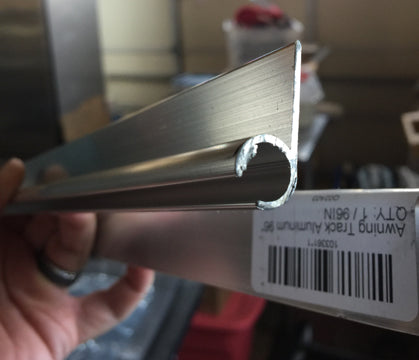
I attached this to the frame on my trailer that holds my solar panels. This track could be installed directly on the trailer since most trailers will not have a rack like I do. It is best to use self-tapping screws. There are small sliders that fit into the awning track.
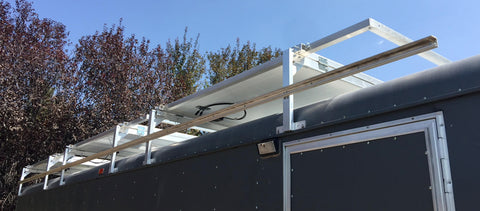
I threaded some cord through the sliders and attached a carabiner.
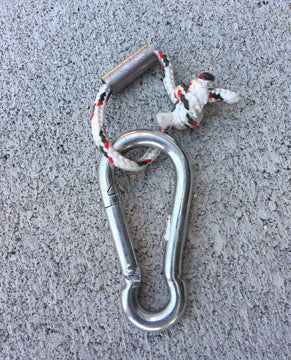
I placed the sliders/carbiners into the track and then attached the shade cloth to the carabiners.
This system provided a secure method of attaching one side of the shade cloth to the trailer. I used the military poles on the other side. My trailer was parked about 5 feet from my tent, which created a nice shady spot to store my coolers and other gear.
4. Tent, seating/eating area, meeting area? We covered a 15 ft long pop up trailer, 10x20 kitchen tent, a 18x18 tent and had enough left over to have an open space for our evening potluck meals.
5. "I covered my tent but it also extended out 10’ on both sides and in the front." Unfortunately there are no photos of this camp, but the owner provided some drawings.
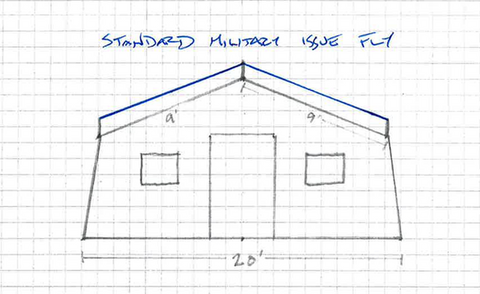
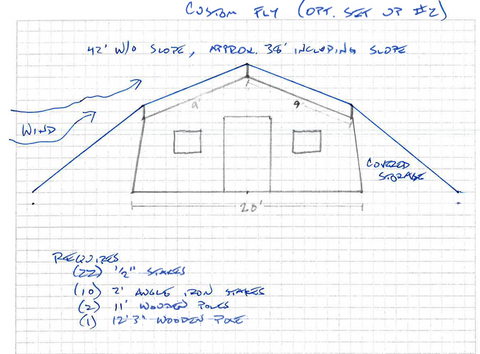
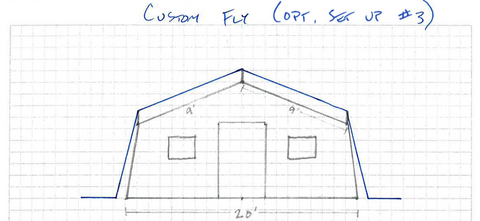

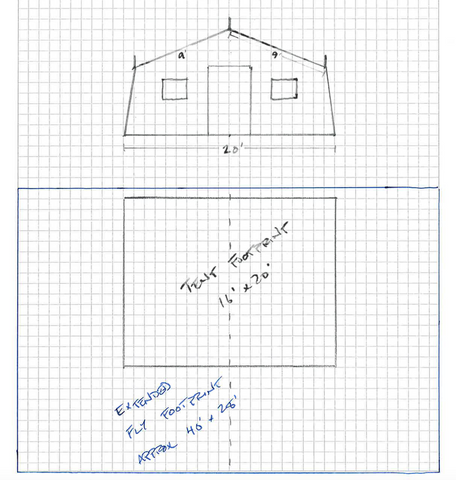
How effective was it in reducing temperature, very, medium, not much?
1. An observation: the tents that had the shade over them, especially with an air gap between the shade and the tent, were much cooler than those that were exposed to direct sun.
2. I did not measure the temp but people could tell the difference between being in the full sun and under the shade tarp.
3. Very effective – a 10 degree reduction in heat
4. Very effective. You could feel the difference when the sun was out by leaving the shade cloth and returning back.
5. It’s difficult to say because the weather (heat) was mild. But, I was very satisfied with it.
What type did you buy - % darkness?
1. Ours were 60-70%. We have investigated commercial shade cloth, both standard and custom sizes. They are available as woven or knitted, some with a multitude of color options. Mostly we have looked at 87% sun filtering shades. While the 60-70% cloths make a significant difference when standing under them in direct sunlight, we still found ourselves seeking full shade in the middle of the afternoon. We did enjoy the breezes that could move through and under the shade in the classroom seating area.
2. I purchased the 60% shade tarp. It was better priced and already made into the size I wanted.
3. 90%
4. 60%
5. NOT a shade cloth – but an extended fly, so I assume that would be 100% darkness
Where did you buy it?
1. Cal Ranch
2. greenhousemegastore.com
3. growersolution.com
4. Father in law bought it. I don't know where.
5. emergencydisasterprep.com
Pricing - I priced a 30x30 feet 90% shade cloth with grommets every 2 feet which weighs approximately 25 pounds. Total price, including shipping to Provo, UT is:
1. greenhousemegastore.com - $330.70
2. growerssolution.com - $396.90 (free shipping)
I do not know the comparative quality of the products from these two companies
What size/types of poles did you buy?
2. I purchases the military camo poles on a group buy from surplus. (4-foot extension poles and the butterfly extenders for the top against the shade cloth. They cover a larger area than the mushroom type.
4. Military camouflage support systems. We used a total of 36 4' poles to hold up the shade cloth and approximately 12 spreaders.
5. Old military poles & guy lines
How did you determine how many poles to buy?
2. I put my tent(s), kitchen, shower, and bathroom on a grid and figured out how many to get.
4. We positioned 2 4' poles around the perimeter about every 12 1/2 feet. Then we placed 3 4' poles (12 feet high) to go over all the high geodomes or military tents. We used 4 of those at that size.
5. I counted the eyelets in the fly because it was designed specifically for my TEMPER tent.
Any suggestions for someone considering shade cloth for long term camping, i.e. grommets, size, poles, % darkness, etc.
1. We are likely to look for another cloth to cover our Geoshelter dome, but might decide to just get by with the makeshift shade we had.
2. Had I to do it again I would pay the extra $ and get the 90% shade cloth. It requires more tie downs and poles because the weave is closer together than the 60% thus making a bigger risk for wind. I recommend grommets every 2 feet. I weave rope between all of the grommets to go around the perimeter of the shade cloth. I secure the tie-downs with a small carabineer (dollar store) to the shade cloth and stake it to the ground. I learned the hard way not to tie rope to the individual grommets. Severe wind can rip the material around the grommet. The higher the percentage of shade the greater the need to secure the shade cloth against wind. Another thing I learned was to tie off the support poles about 4 feet down from the top of the shade cloth to a 3-point anchor. There is so much movement in the shade cloth during a windstorm that any poles over 8 feet would fall over. The 3-point anchor made a huge difference keeping the shade tarp up during a windstorm.
3. We modified our trailer so that we could attach our shade cloth to it for stability and giving us space between the trailer and tent shade enough to keep coolers cooler.
4. Quality counts here. Some were purchased without grommets and it made a difference. Tension is very important, the shade cloth has to pulled tight. As wind billowed through camp, it would push up the poles and spreaders that were in the middle of the shade cloth and they would fall over. As we got the tension tighter, it happened less. (We finally fixed it completely by securing the spreaders to the shade cloth with zip-ties.
5. I think the shade cloth is a good idea, however I feel my extended fly will serve me better long term because it is more versatile. The shade cloth does a good job shading but won’t protect your “stuff” from the elements. I can easily lower and secure my fly by kicking out the poles on the sides and staking the fly to the ground to force the wind right over the top of my tent. The only down side to my fly is that it weighs A LOT – probably 200 pounds.
Some additional information from these campers -
Regarding poles and spreaders - Aluminum poles are more sturdy and are recommended. Several campers had fiberglass poles break. The type of spreader is the one with the three prongs. These are more secure and do not slide like the smaller mushroom style. The poles are interlocking so you can have 4, 8 and 12 foot poles. You can find poles and spreaders at ebay, military surplus stores and online. Here is a site that has them: Colemans Military Surplus
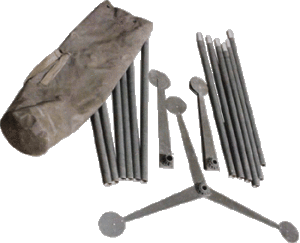
The information in this article is provided by campers that are still learning and would not consider themselves experts on shade cloth. If you have any questions or comments regarding this article, please post a question and I will do my best to find out the answers. Suggestions from others that have learned lessons about shade cloth are appreciated.
Free Sink Carrying Case
BTW, at this camp I saw dozens of Deluxe Camp Sinks and Deluxe Tent Showers. Several women sought me out to thank me for making their camp more clean and comfortable. If you haven't got your camp sink and shower don't wait.
 USD
USD EUR
EUR





